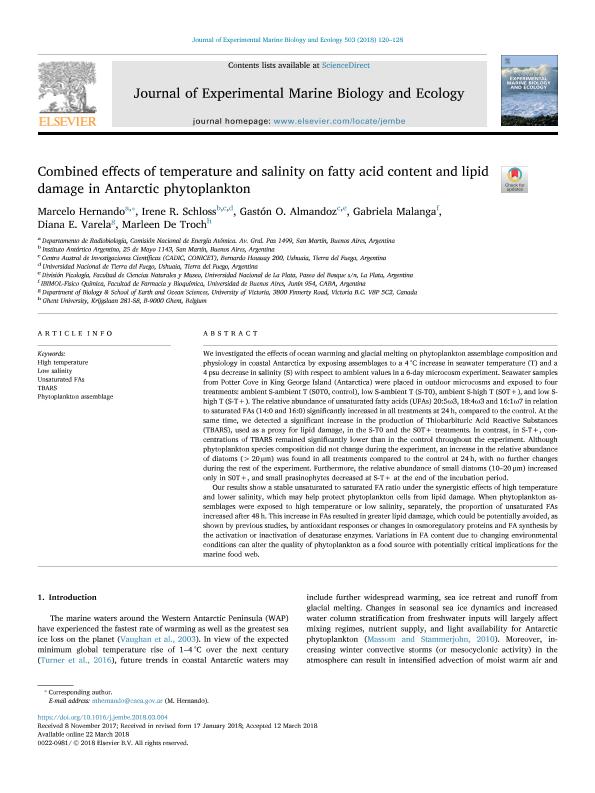Mostrar el registro sencillo del ítem
dc.contributor.author
Hernando, Marcelo Pablo

dc.contributor.author
Schloss, Irene Ruth

dc.contributor.author
Almandoz, Gaston Osvaldo

dc.contributor.author
Malanga, Gabriela Fabiana

dc.contributor.author
Varela, Diana E.
dc.contributor.author
De Troch, Marleen
dc.date.available
2019-11-26T20:37:49Z
dc.date.issued
2018-06
dc.identifier.citation
Hernando, Marcelo Pablo; Schloss, Irene Ruth; Almandoz, Gaston Osvaldo; Malanga, Gabriela Fabiana; Varela, Diana E.; et al.; Combined effects of temperature and salinity on fatty acid content and lipid damage in Antarctic phytoplankton; Elsevier Science; Journal of Experimental Marine Biology and Ecology; 503; 6-2018; 120-128
dc.identifier.issn
0022-0981
dc.identifier.uri
http://hdl.handle.net/11336/90574
dc.description.abstract
We investigated the effects of ocean warming and glacial melting on phytoplankton assemblage composition and physiology in coastal Antarctica by exposing assemblages to a 4 °C increase in seawater temperature (T) and a 4 psu decrease in salinity (S) with respect to ambient values in a 6-day microcosm experiment. Seawater samples from Potter Cove in King George Island (Antarctica) were placed in outdoor microcosms and exposed to four treatments: ambient S-ambient T (S0T0, control), low S-ambient T (S-T0), ambient S-high T (S0T+), and low S-high T (S-T+). The relative abundance of unsaturated fatty acids (UFAs) 20:5ω3, 18:4ω3 and 16:1ω7 in relation to saturated FAs (14:0 and 16:0) significantly increased in all treatments at 24 h, compared to the control. At the same time, we detected a significant increase in the production of Thiobarbituric Acid Reactive Substances (TBARS), used as a proxy for lipid damage, in the S-T0 and the S0T+ treatments. In contrast, in S-T+, concentrations of TBARS remained significantly lower than in the control throughout the experiment. Although phytoplankton species composition did not change during the experiment, an increase in the relative abundance of diatoms (>20 μm) was found in all treatments compared to the control at 24 h, with no further changes during the rest of the experiment. Furthermore, the relative abundance of small diatoms (10–20 μm) increased only in S0T+, and small prasinophytes decreased at S-T+ at the end of the incubation period. Our results show a stable unsaturated to saturated FA ratio under the synergistic effects of high temperature and lower salinity, which may help protect phytoplankton cells from lipid damage. When phytoplankton assemblages were exposed to high temperature or low salinity, separately, the proportion of unsaturated FAs increased after 48 h. This increase in FAs resulted in greater lipid damage, which could be potentially avoided, as shown by previous studies, by antioxidant responses or changes in osmoregulatory proteins and FA synthesis by the activation or inactivation of desaturase enzymes. Variations in FA content due to changing environmental conditions can alter the quality of phytoplankton as a food source with potentially critical implications for the marine food web.
dc.format
application/pdf
dc.language.iso
eng
dc.publisher
Elsevier Science

dc.rights
info:eu-repo/semantics/openAccess
dc.rights.uri
https://creativecommons.org/licenses/by-nc-sa/2.5/ar/
dc.subject
HIGH TEMPERATURE
dc.subject
LOW SALINITY
dc.subject
PHYTOPLANKTON ASSEMBLAGE
dc.subject
TBARS
dc.subject
UNSATURATED FAS
dc.subject.classification
Biología Marina, Limnología

dc.subject.classification
Ciencias Biológicas

dc.subject.classification
CIENCIAS NATURALES Y EXACTAS

dc.title
Combined effects of temperature and salinity on fatty acid content and lipid damage in Antarctic phytoplankton
dc.type
info:eu-repo/semantics/article
dc.type
info:ar-repo/semantics/artículo
dc.type
info:eu-repo/semantics/publishedVersion
dc.date.updated
2019-10-23T21:00:43Z
dc.journal.volume
503
dc.journal.pagination
120-128
dc.journal.pais
Países Bajos

dc.journal.ciudad
Amsterdam
dc.description.fil
Fil: Hernando, Marcelo Pablo. Comisión Nacional de Energía Atómica; Argentina
dc.description.fil
Fil: Schloss, Irene Ruth. Ministerio de Relaciones Exteriores, Comercio Interno y Culto. Dirección Nacional del Antártico. Instituto Antártico Argentino; Argentina. Consejo Nacional de Investigaciones Científicas y Técnicas. Centro Austral de Investigaciones Científicas; Argentina. Universidad Nacional de Tierra del Fuego; Argentina
dc.description.fil
Fil: Almandoz, Gaston Osvaldo. Consejo Nacional de Investigaciones Científicas y Técnicas. Centro Austral de Investigaciones Científicas; Argentina. Universidad Nacional de La Plata. Facultad de Ciencias Naturales y Museo. División Ficología; Argentina
dc.description.fil
Fil: Malanga, Gabriela Fabiana. Consejo Nacional de Investigaciones Científicas y Técnicas. Oficina de Coordinación Administrativa Houssay. Instituto de Bioquímica y Medicina Molecular. Universidad de Buenos Aires. Facultad Medicina. Instituto de Bioquímica y Medicina Molecular; Argentina
dc.description.fil
Fil: Varela, Diana E.. University of Victoria; Canadá
dc.description.fil
Fil: De Troch, Marleen. University of Ghent; Bélgica
dc.journal.title
Journal of Experimental Marine Biology and Ecology

dc.relation.alternativeid
info:eu-repo/semantics/altIdentifier/url/https://www.sciencedirect.com/science/article/pii/S0022098117306019
dc.relation.alternativeid
info:eu-repo/semantics/altIdentifier/doi/https://doi.org/10.1016/j.jembe.2018.03.004
Archivos asociados
